Abstract
Antisera were raised against the chemically synthesized peptide corresponding to each epitope of three foot-and-mouth disease virus strains. Peptide synthesis was further used to determine which amino acid residues in each epitope are important for the specificity of antisera raised against the whole virus. The specificity of the antibody paratope for its epitope was shown to depend on structure as well as sequence. Anti-virus sera demonstrated a greater specificity for the homologous peptide than did the anti-peptide sera. Two of the three peptides were able to induce neutralizing antibodies against the homologous virus. The specificities of the antibodies present in the anti-peptide sera were also inferred from the reactions of each with related sets of peptides. The cross-reactions observed for the anti-peptide sera were readily explained in terms of the antibody specificities determined to be present. The findings also suggest that the diversity of antibodies raised against small peptides is limited and is determined by the immune system. A similar limited response to the native protein was observed, which may account for the high frequency with which anti-peptide sera react with the native homologous protein.
Full text
PDF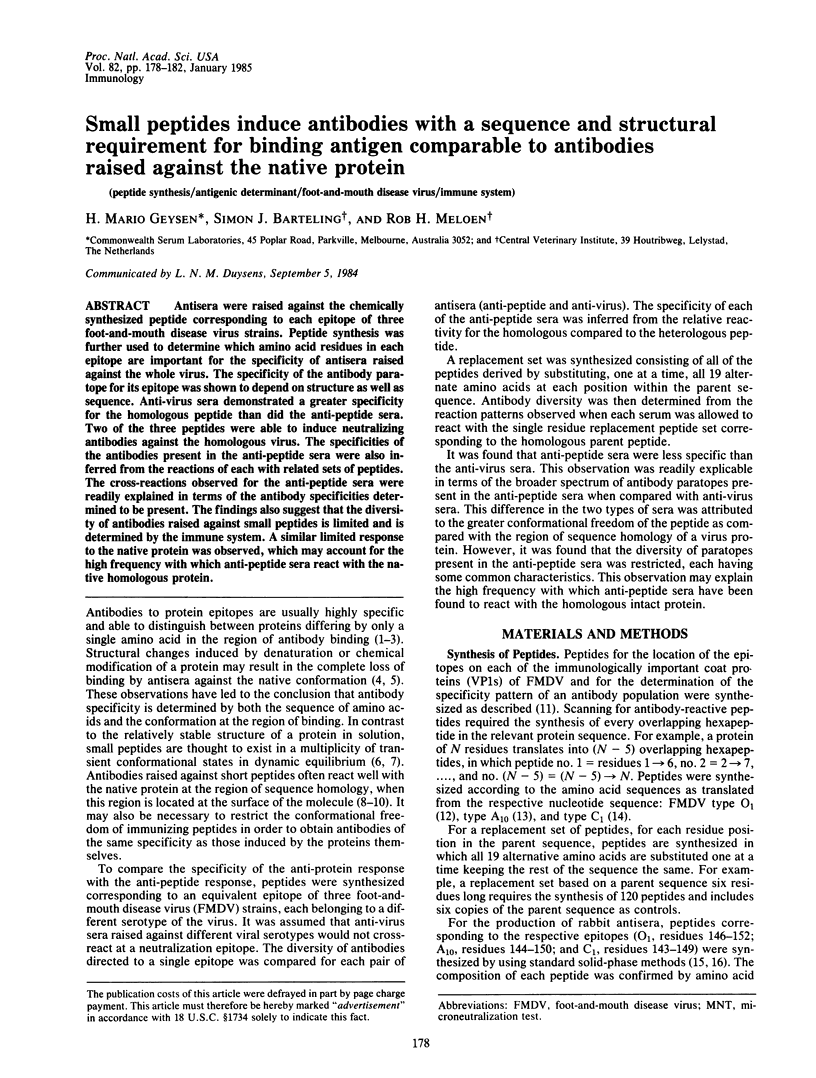
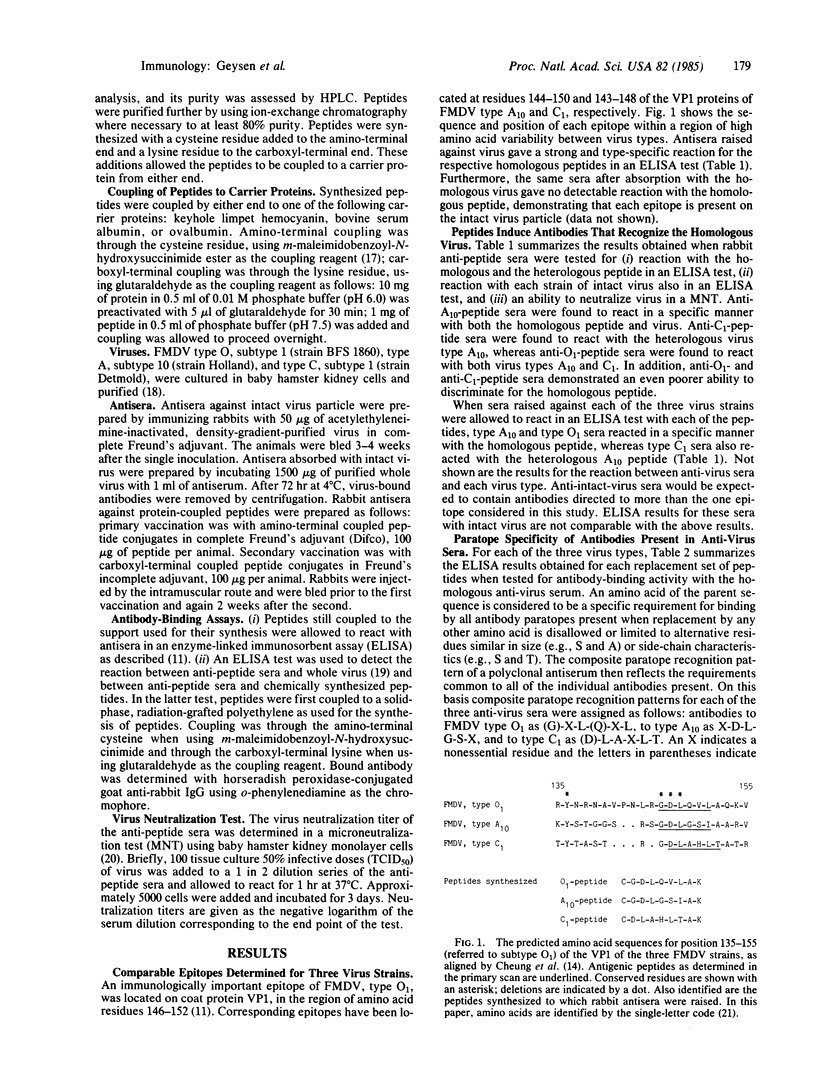
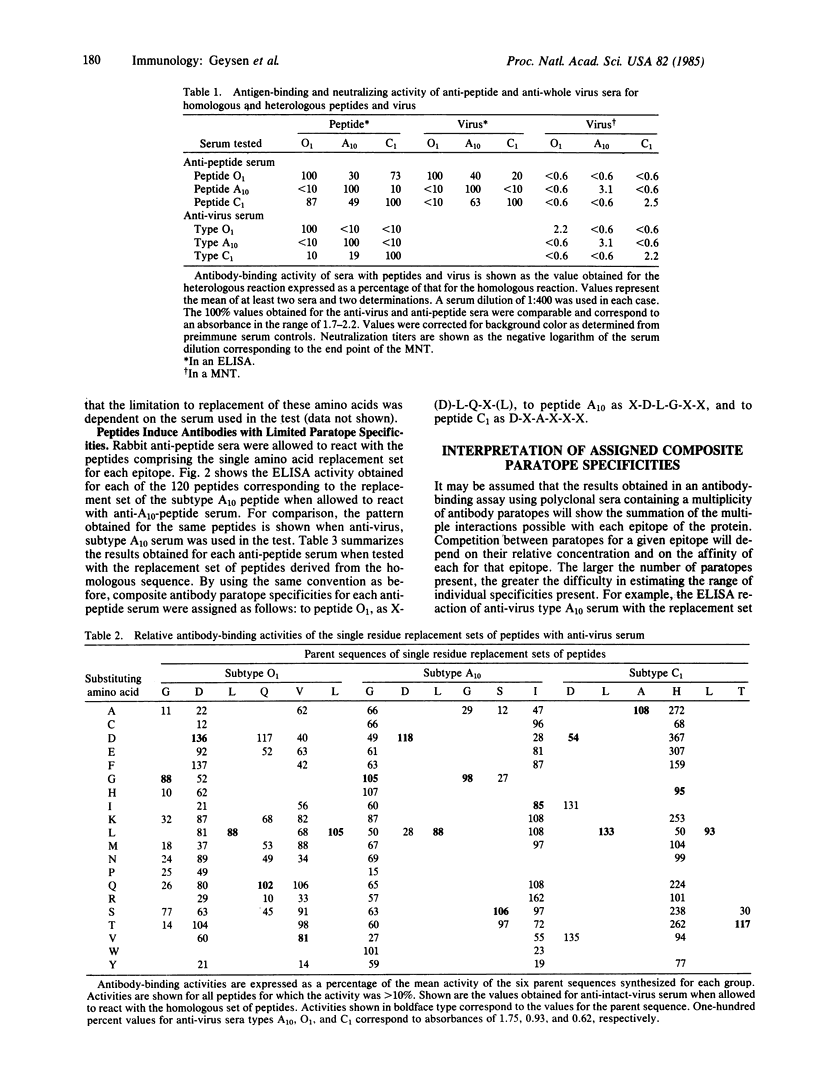
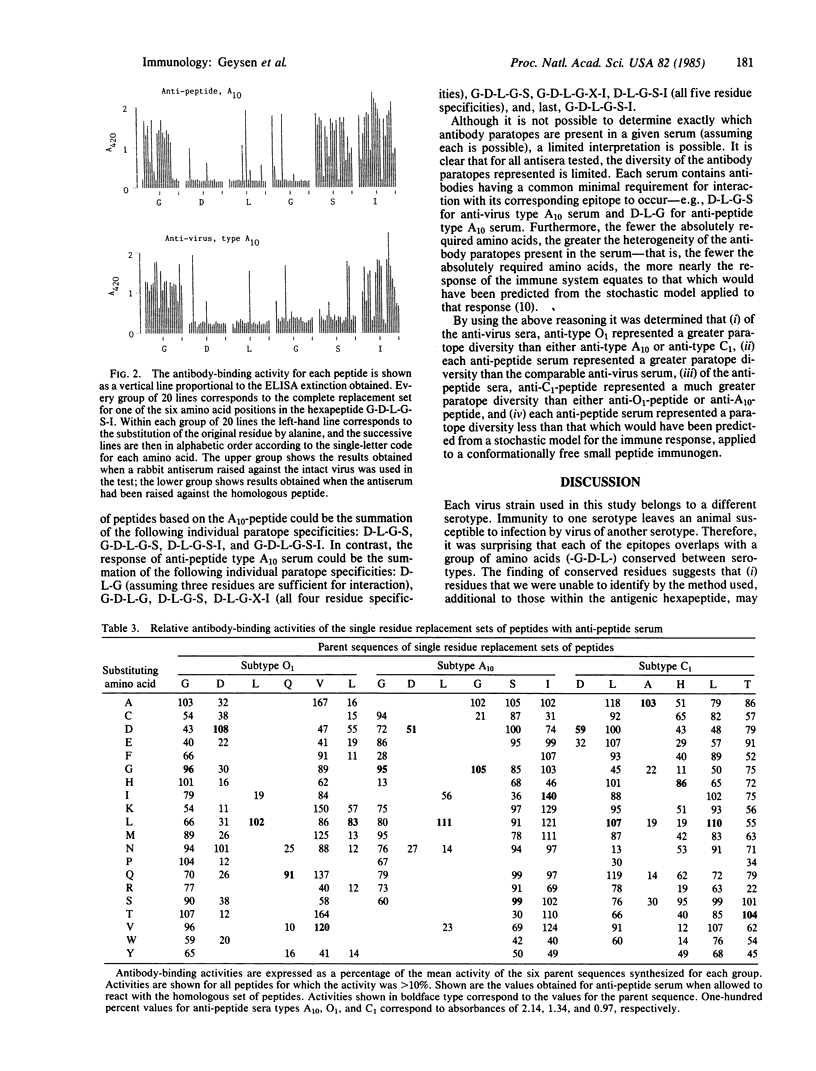
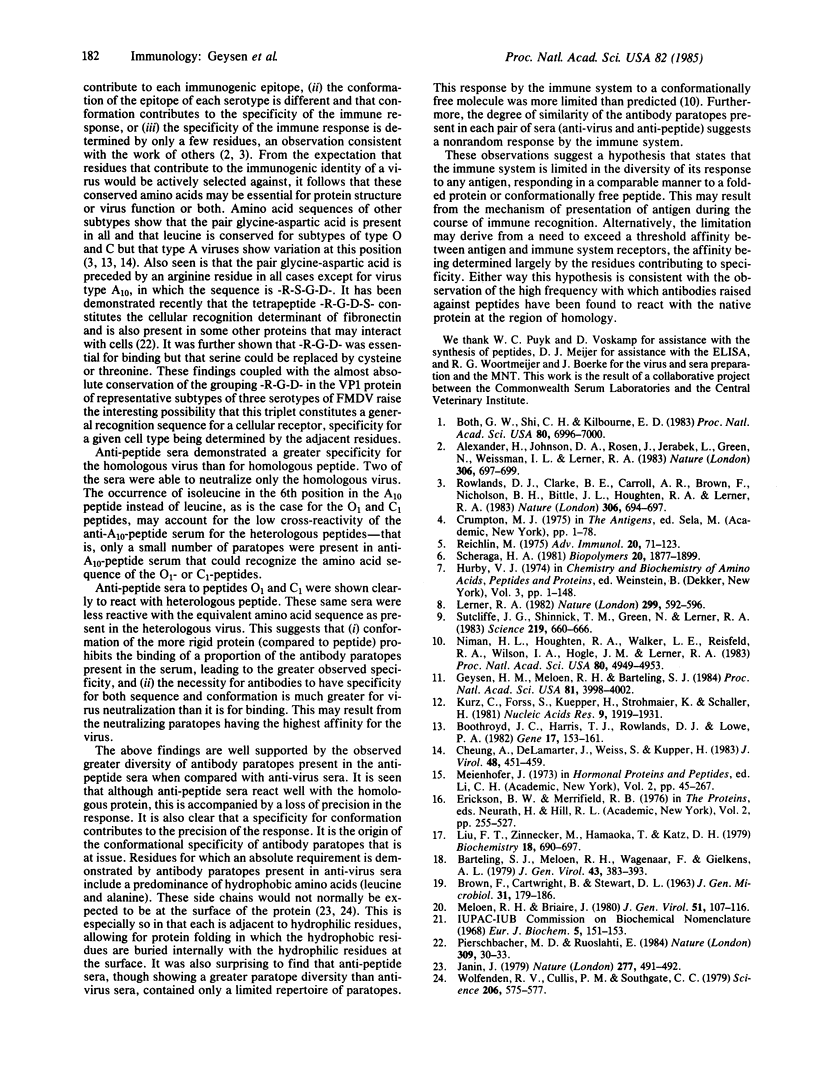
Selected References
These references are in PubMed. This may not be the complete list of references from this article.
- Alexander H., Johnson D. A., Rosen J., Jerabek L., Green N., Weissman I. L., Lerner R. A. Mimicking the alloantigenicity of proteins with chemically synthesized peptides differing in single amino acids. Nature. 1983 Dec 15;306(5944):697–699. doi: 10.1038/306697a0. [DOI] [PubMed] [Google Scholar]
- Barteling S. J., Meloen R. H., Wagenaar F., Gielkens A. L. Isolation and characterization of trypsin-resistant O1 variants of foot-and-mouth disease virus. J Gen Virol. 1979 May;43(2):383–393. doi: 10.1099/0022-1317-43-2-383. [DOI] [PubMed] [Google Scholar]
- Boothroyd J. C., Harris T. J., Rowlands D. J., Lowe P. A. The nucleotide sequence of cDNA coding for the structural proteins of foot-and-mouth disease virus. Gene. 1982 Feb;17(2):153–161. doi: 10.1016/0378-1119(82)90068-3. [DOI] [PubMed] [Google Scholar]
- Both G. W., Shi C. H., Kilbourne E. D. Hemagglutinin of swine influenza virus: a single amino acid change pleiotropically affects viral antigenicity and replication. Proc Natl Acad Sci U S A. 1983 Nov;80(22):6996–7000. doi: 10.1073/pnas.80.22.6996. [DOI] [PMC free article] [PubMed] [Google Scholar]
- Cheung A., DeLamarter J., Weiss S., Küpper H. Comparison of the major antigenic determinants of different serotypes of foot-and-mouth disease virus. J Virol. 1983 Nov;48(2):451–459. doi: 10.1128/jvi.48.2.451-459.1983. [DOI] [PMC free article] [PubMed] [Google Scholar]
- Geysen H. M., Meloen R. H., Barteling S. J. Use of peptide synthesis to probe viral antigens for epitopes to a resolution of a single amino acid. Proc Natl Acad Sci U S A. 1984 Jul;81(13):3998–4002. doi: 10.1073/pnas.81.13.3998. [DOI] [PMC free article] [PubMed] [Google Scholar]
- Janin J. Surface and inside volumes in globular proteins. Nature. 1979 Feb 8;277(5696):491–492. doi: 10.1038/277491a0. [DOI] [PubMed] [Google Scholar]
- Kurz C., Forss S., Küpper H., Strohmaier K., Schaller H. Nucleotide sequence and corresponding amino acid sequence of the gene for the major antigen of foot and mouth disease virus. Nucleic Acids Res. 1981 Apr 24;9(8):1919–1931. doi: 10.1093/nar/9.8.1919. [DOI] [PMC free article] [PubMed] [Google Scholar]
- Liu F. T., Zinnecker M., Hamaoka T., Katz D. H. New procedures for preparation and isolation of conjugates of proteins and a synthetic copolymer of D-amino acids and immunochemical characterization of such conjugates. Biochemistry. 1979 Feb 20;18(4):690–693. doi: 10.1021/bi00571a022. [DOI] [PubMed] [Google Scholar]
- Meloen R. H., Briaire J. A study of the cross-reacting antigens on the intact foot-and-mouth disease virus and its 12S Subunits with antisera against the structural proteins. J Gen Virol. 1980 Nov;51(Pt 1):107–116. doi: 10.1099/0022-1317-51-1-107. [DOI] [PubMed] [Google Scholar]
- Niman H. L., Houghten R. A., Walker L. E., Reisfeld R. A., Wilson I. A., Hogle J. M., Lerner R. A. Generation of protein-reactive antibodies by short peptides is an event of high frequency: implications for the structural basis of immune recognition. Proc Natl Acad Sci U S A. 1983 Aug;80(16):4949–4953. doi: 10.1073/pnas.80.16.4949. [DOI] [PMC free article] [PubMed] [Google Scholar]
- Pierschbacher M. D., Ruoslahti E. Cell attachment activity of fibronectin can be duplicated by small synthetic fragments of the molecule. Nature. 1984 May 3;309(5963):30–33. doi: 10.1038/309030a0. [DOI] [PubMed] [Google Scholar]
- Reichlin M. Amino acid substitution and the antigenicity of globular proteins. Adv Immunol. 1975;20:71–123. doi: 10.1016/s0065-2776(08)60207-2. [DOI] [PubMed] [Google Scholar]
- Rowlands D. J., Clarke B. E., Carroll A. R., Brown F., Nicholson B. H., Bittle J. L., Houghten R. A., Lerner R. A. Chemical basis of antigenic variation in foot-and-mouth disease virus. Nature. 1983 Dec 15;306(5944):694–697. doi: 10.1038/306694a0. [DOI] [PubMed] [Google Scholar]
- Sutcliffe J. G., Shinnick T. M., Green N., Lerner R. A. Antibodies that react with predetermined sites on proteins. Science. 1983 Feb 11;219(4585):660–666. doi: 10.1126/science.6186024. [DOI] [PubMed] [Google Scholar]
- Wolfenden R. V., Cullis P. M., Southgate C. C. Water, protein folding, and the genetic code. Science. 1979 Nov 2;206(4418):575–577. doi: 10.1126/science.493962. [DOI] [PubMed] [Google Scholar]


